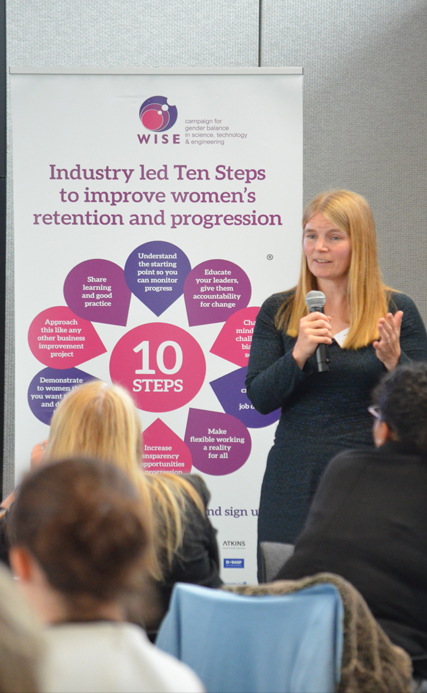Female representation in technology has been static for 10 years. But could the pandemic provide the opportunity to improve gender diversity in tech? asks Trudy Norris-Grey, Chair of WISE, the campaign for gender balance in STEM. In this week’s guest column, she explores how HR and DE&I professionals can help CIOs and CTOs, attract, retain and develop opportunities for women in tech.
Last year, we announced that there were one million women working in STEM roles. Yet disappointingly in IT – my own profession – women represent just 16%; a figure that’s been static for 10 years despite enormous efforts to create change. Somewhat ironically the pandemic could provide the ideal opportunity to turn this around.
Today, almost every business relies on tech and the pandemic has driven an acceleration of tech innovation, which along with our increasing reliance on it means there is currently high demand for tech and digital talent. This, combined with Computer Weekly‘s survey on tech jobs, suggests that many people are re-evaluating their view of tech roles; and seeing the profession as a more stable and desirable career option. This could be our opportunity to change the image of the IT profession, attract more women and ensure greater future sustainability.
HOW DO WE DO IT?
Our industry-led 10 Steps, which provide a framework to help firms improve the recruitment, retention and progression of women, have significantly helped to drive change in male-dominated sectors, including engineering and science.
Employers who sign up to the framework show an average improvement of 30% in their diversity and inclusion efforts and more senior women in leadership roles. So below are a few of our steps to help you work with your teams; particularly with your CIOs and CTOs, to improve diversity in your tech teams.
TRANSFORMATION BEGINS WITH LEADERSHIP
Our experience of working with employers shows that the key to recruiting and retaining women in tech and digital roles is to create an inclusive workplace; creating a place where women can be themselves, do their best work and thrive. In traditionally male-dominated sectors, this requires a transformational change programme led from the top by directors who are accountable for it. They also actively take responsibility and steps to change mindsets, speak publicly about the business benefits and call out inappropriate behaviour.
It’s vital for tech that this includes the Chief Information and Technology Officers (CIOs and CTOs). They need to drive the cultural change in the tech departments, as well as support the overarching business drive towards greater diversity and inclusivity.

TREAT INCLUSIVITY LIKE A BUSINESS PROJECT
Creating an inclusive workplace needs to be approached like any other business project. You need to start by establishing a baseline. As well as analysing data from your gender pay gap, which will tell you about women’s representation across the business, you also need to closely examine data from the IT department.
What percentage of employees are women? How many are in senior roles? What is the rate of attrition and are you capturing the reasons for the attrition? This information can help identify where the issues lie, create a proactive plan of action and set realistic targets and timescales which you can use to monitor progress.
SPONSOR WOMEN THE SAME WAY AS MEN
It is also vital to demonstrate to existing female employees that you are committed to retaining and developing them. Ensure that senior leaders sponsor women with high potential to the same extent they do men.
As well as helping women to advance, which in turn will reduce your gender pay gap, sponsorship encourages women to feel they have genuine opportunities to progress their career. If you don’t do this, you run the risk of your best women IT professionals looking elsewhere; perhaps even moving to one of your competitors.
FLEXIBLE WORKING FOR ALL
The pandemic has seen an unprecedented shift to working from home. This is largely expected to become a greater part of how we will work when the pandemic ends. However, so many employers still miss the opportunity to promote their flexible working arrangements to potential recruits and existing employees.
We recommend taking a company-wide approach to flexible working for all employees. This widens your talent pool by allowing people to balance their careers with other commitments such as caring responsibilities. Most IT professionals can work flexibly, so talk to the teams in your business about how they could introduce flexibility to make it work for everyone whilst continuing to meet client expectations.
Don’t forget to also support managers with an understanding of your flexible working policies; as well as offering training to help them learn how to manage remotely. These small changes make all the difference by allowing women to do their roles effectively; and feel welcome in the organisation.
For more information on WISE’s 10 Steps, click here.

AUTHOR BIOGRAPHY
Trudy Norris-Grey is Chair of WISE, the campaign for gender balance in STEM. With over 30 years’ experience, Trudy is a recognised leader in the IT and financial services industries, having held leadership roles at Microsoft, Oracle, Sun Microsystems, and BT. Trudy is a passionate advocate of encouraging women and girls to consider careers in STEM; and helping businesses to embrace diversity and inclusion. She has also been listed in Computer Weekly as one of the ‘top 10 Influential women in IT’.





































